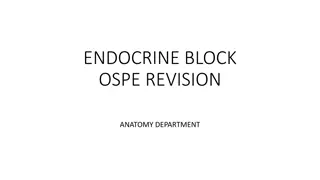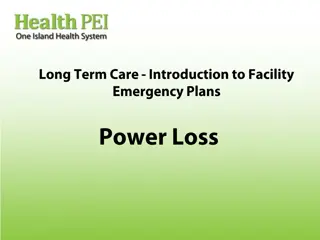
Employer Strategies for Tobacco and Opioid Use
Learn how Indiana employers can address tobacco and opioid use among employees, including the costs of tobacco, recommended approaches, and adequate insurance coverage for smoking cessation. Discover actionable steps to lower smoking rates and mitigate opioid misuse in the workplace.
Download Presentation

Please find below an Image/Link to download the presentation.
The content on the website is provided AS IS for your information and personal use only. It may not be sold, licensed, or shared on other websites without obtaining consent from the author. If you encounter any issues during the download, it is possible that the publisher has removed the file from their server.
You are allowed to download the files provided on this website for personal or commercial use, subject to the condition that they are used lawfully. All files are the property of their respective owners.
The content on the website is provided AS IS for your information and personal use only. It may not be sold, licensed, or shared on other websites without obtaining consent from the author.
E N D
Presentation Transcript
What Can Employers Do About Tobacco and Opioid Use? BioCrossroads Frameworx April 13, 2017
Overview of the Richard M. Fairbanks Foundation The Richard M. Fairbanks Foundation strives to advance the vitality of Indianapolis and the well-being of its people by addressing the city s most significant challenges and opportunities. The Foundation is focused on three issue-areas: education, tobacco and opioid addiction, and the life-sciences. To advance its work, the Foundation implements a three-pronged approach: strategic grantmaking evidence-based advocacy cross-sector collaborations and convenings. Learn more at www.RMFF.org 2
Focus of Todays Discussion Tobacco and opioid use among employees cost Indiana employers There are concrete, proven steps employers can take to lower smoking rates and address opioid misuse with their employees Employers can also leverage their corporate giving programs as well as their employees to help ensure proven prevention programs are implemented in schools, colleges and universities 3
The costs of tobacco for Indiana employers Smokers cost employers $6,000 more per year than nonsmokers This comes from higher absenteeism, reduced productivity when at work, and elevated health insurance costs 5
What Indiana employers can do about tobacco Health and business experts recommend three approaches: 1. Provide adequate insurance coverage for smoking cessation 2. Offer financial incentives for employees to quit smoking 3. Extend and strengthen smoke-free policies on employer property 6
What is adequate insurance coverage for tobacco? The CDC, National Business Group on Health and others recommend that coverage include: Screening for tobacco at every clinical encounter Full range of counseling for tobacco cessation All FDA-approved tobacco cessation medications Coverage for at least 2 quit attempts per year Screening, counseling and tobacco cessation medication are evidence- based interventions for lowering smoking rates 7
Financial incentives for quitting Financial incentives include cash prizes for employees who quit, as well as health insurance discounts or additional HSA contributions for nonsmokers Example: General Electric piloted a program that gave employees $100 to attend smoking cessation classes and up to $650 more if they quit smoking for 12 months 8
The impact of GEs smoking incentive program Independent research found GE s incentive program tripled quit rates 15% 5% No Incentive Incentive Given this impact, GE decided to scale up the pilot program company-wide 9
Smoke-free policies Indiana law prohibits smoking in many workplaces Several cities have stronger ordinances that include workplaces exempted from the state law, such as bars Still, there is scope for extending and strengthening smoke-free polices: Colleges and universities Smoke-free means no smoking indoors or outdoors Only 20 Indiana colleges and universities are currently smoke-free Bars and restaurants Currently exempt from smoke- free policies in parts of the state Going smoke-free can help improve both health and business outcomes Better reach and enforcement Extend smoke-free policies to include parking lots, other parts of employer property Enforce smoke-free policies, especially near building entrances/exits 10
The costs of opioids for Indiana employers Drug overdose, largely driven by opioids, now causes more deaths than car crashes 80% of Indiana employers have observed prescription drug misuse among employees Opioid and prescription drug misuse can lead to: Higher risk of injury or critical errors on the job Lower productivity Higher healthcare costs Higher costs from replacing employees 12
What Indiana employers can do about opioids The National Safety Council recommends 3 approaches: 1. Provide education on opioids to employees and supervisors Explain risks of opioids, signs an employee may have substance use disorder and where to go to learn about evidence-based treatment 2. Expand drug testing panels to include opioids 90% of Indiana employers drug test, but only half test for Rx opioids 3. Provide confidential access to treatment Employment Assistance Programs have an ROI of $6-$7 per $1 spent 13
Prevention programs in schools and post-secondary institutions Many schools develop homegrown programs without any evidence base, or rely on outdated programs like D.A.R.E., which have been proven to have no efficacy Evidence-based programs exist and should be implemented in schools every year, beginning no later than 7th grade. Prevention should continue through post- secondary education. Many employers have strong partnerships with local schools and universities. Employees or corporate giving programs could audit local schools and universities to ensure evidence-based programs are in place, and consider providing seed funding to bring proven programs into schools and colleges. Top-rated evidence-based program: LifeSkills (for tobacco, alcohol and opioids) https://www.lifeskillstraining.com/index.php. See also this video from the Wall Street Journal: http://www.wsj.com/video/schools- ramping-up-opioid-abuse-program/27DD73BB-529F-4216-B27C-72C00860CCE9.html 15
Step-by-step guidance and sample employer policies on tobacco cessation The Memphis Business Group s Tobacco Use Resources http://www.memphisbusinessgroup.org/tobacco-use Smoking Cessation Benefit Design http://publichealthlawcenter.org/sites/default/files/resources/ws-news- complete-10-09.pdf Smoking Cessation ROI Calculator for Employers http://www.businesscaseroi.org/roi/default.aspx Adopting Tobacco-Free Policies on Campuses http://publichealthlawcenter.org/sites/default/files/resources/adopting- tobacco-free-campus-policies-2016.pdf 17
Additional references for data cited on tobacco Tobacco Use: A Threat to Workplace Health and Productivity http://www.cdcfoundation.org/businesspulse/tobacco-use-infographic What Happened When GE Paid Employees to Quit Smoking? http://www.commonwealthfund.org/publications/newsletters/purchasing- high-performance/2009/june-18-2009/case-studies/what-happened-when- ge-paid-employees-to-quit-smoking Angie s List: Employee Benefits https://careers.angieslist.com/benefits No Smoke s List of Smoke-Free Colleges and Universities http://no-smoke.org/pdf/smokefreecollegesuniversities.pdf 18
Step-by-step guidance and sample employer policies on opioid use disorder The Proactive Role Employers Can Take: Opioids in the Workplace http://www.nsc.org/RxDrugOverdoseDocuments/proactive-role-employers- can-take-opioids-in-the-workplace.pdf Addressing Opioids in the Workplace: Employer Policies Under the Microscope http://www.nsc.org/learn/NSC-Initiatives/Pages/prescription-painkillers-for- employers.aspx 19
Additional references for data cited on opioid use Prescription Drug Impact in the Workplace http://indianawellnesssummit.com/wp-content/uploads/2016/09/2A.pdf EAP Effectiveness and ROI https://www.easna.org/wp-content/uploads/2010/08/EASNA-Research- Notes-No-3-ROI-NOV12010.pdf SAMHSA National Registry of Evidence-Based Programs and Practices (NREPP). URL: http://nrepp.samhsa.gov/. U.S. Surgeon General (2016). Facing Addiction: The Surgeon General s Report on Alcohol, Drugs and Health. URL: https://addiction.surgeongeneral.gov/surgeon-generals-report.pdf. Appendix B. 20






















